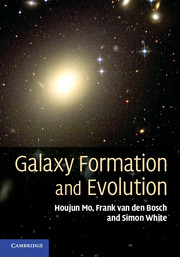Book contents
- Frontmatter
- Contents
- Preface
- 1 Introduction
- 2 Observational Facts
- 3 Cosmological Background
- 4 Cosmological Perturbations
- 5 Gravitational Collapse and Collisionless Dynamics
- 6 Probing the Cosmic Density Field
- 7 Formation and Structure of Dark Matter Halos
- 8 Formation and Evolution of Gaseous Halos
- 9 Star Formation in Galaxies
- 10 Stellar Populations and Chemical Evolution
- 11 Disk Galaxies
- 12 Galaxy Interactions and Transformations
- 13 Elliptical Galaxies
- 14 Active Galaxies
- 15 Statistical Properties of the Galaxy Population
- 16 The Intergalactic Medium
- A Basics of General Relativity
- B Gas and Radiative Processes
- C Numerical Simulations
- D Frequently Used Abbreviations
- E Useful Numbers
- References
- Index
1 - Introduction
Published online by Cambridge University Press: 05 June 2012
- Frontmatter
- Contents
- Preface
- 1 Introduction
- 2 Observational Facts
- 3 Cosmological Background
- 4 Cosmological Perturbations
- 5 Gravitational Collapse and Collisionless Dynamics
- 6 Probing the Cosmic Density Field
- 7 Formation and Structure of Dark Matter Halos
- 8 Formation and Evolution of Gaseous Halos
- 9 Star Formation in Galaxies
- 10 Stellar Populations and Chemical Evolution
- 11 Disk Galaxies
- 12 Galaxy Interactions and Transformations
- 13 Elliptical Galaxies
- 14 Active Galaxies
- 15 Statistical Properties of the Galaxy Population
- 16 The Intergalactic Medium
- A Basics of General Relativity
- B Gas and Radiative Processes
- C Numerical Simulations
- D Frequently Used Abbreviations
- E Useful Numbers
- References
- Index
Summary
This book is concerned with the physical processes related to the formation and evolution of galaxies. Simply put, a galaxy is a dynamically bound system that consists of many stars. A typical bright galaxy, such as our own Milky Way, contains a few times 1010 stars and has a diameter (~ 20kpc) that is several hundred times smaller than the mean separation between bright galaxies. Since most of the visible stars in the Universe belong to a galaxy, the number density of stars within a galaxy is about 107 times higher than the mean number density of stars in the Universe as a whole. In this sense, galaxies are well-defined, astronomical identities. They are also extraordinarily beautiful and diverse objects whose nature, structure and origin have intrigued astronomers ever since the first galaxy images were taken in the mid-nineteenth century.
The goal of this book is to show how physical principles can be used to understand the formation and evolution of galaxies. Viewed as a physical process, galaxy formation and evolution involve two different aspects: (i) initial and boundary conditions; and (ii) physical processes which drive evolution. Thus, in very broad terms, our study will consist of the following parts:
• Cosmology: Since we are dealing with events on cosmological time and length scales, we need to understand the space-time structure on large scales. One can think of the cosmological framework as the stage on which galaxy formation and evolution take place.
- Type
- Chapter
- Information
- Galaxy Formation and Evolution , pp. 1 - 24Publisher: Cambridge University PressPrint publication year: 2010



